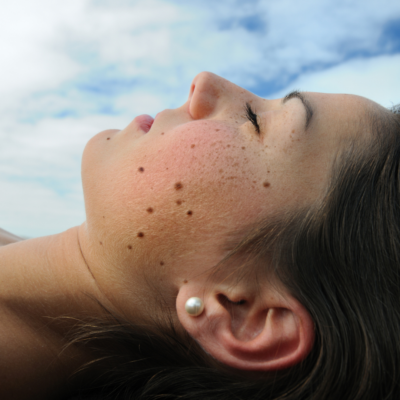Microdermabrasion
Microdermabrasion is an exfoliation treatment designed to remove the upper layers of damaged and dying skin cells, which tend to give your skin an overall dull appearance and betray signs of sun damage. In addition to general exfoliation of the skin, California Skin Institute aestheticians can use this treatment to target specific problems like dark spots on face, acne scars, and hyperpigmentation induced by pregnancy.
After the top layer of skin cells has been removed, the skin should look more radiant and should feel refreshed. Further, many of our clients find that the need to use large quantities of makeup decreases with improved texture and elimination of skin imperfections. This decrease in makeup use after regular treatments allows the pores to “breathe” better, and promotes better long term skin health.
How Microdermabrasion Works
Microdermabrasion is a term used to describe a number of different procedures which exfoliate the skin. During this procedure, the top layer of the epidermis is removed. Your dead skin cells are subsequently vacuumed up, revealing healthy skin. The whole procedure is quick and painless, generally taking 30-45 minutes, depending on your unique situation. To better understand this procedure, let’s look at two main types of microdermabrasion; crystal-based and non-crystal.
The crystal-based microdermabrasion technique uses very fine crystals that are projected at the skin at a relatively high speed. Such machines usually have a tool tip that gently suctions the skin while delivering the crystals with a blast of air. As the crystals come in contact with the skin, they scrape off the upper-most layer of cells, and are then sucked back into the machine. After the crystal microdermabrasion procedure is complete, any particles that are left on the skin are gently wiped off.
Non-crystal microdermabrasion is used to describe procedures that don’t use crystals, and instead utilize diamond-tipped tooltips or systems that utilize bristles (like DermaSweep). During such procedures, the skin is scraped by the tool tip, and the dead skin cells are suctioned into a special cartridge as they become dislodged.
It is important to note that regardless of which procedure is utilized, the suctioning is quite mild and does not cause broken capillaries in most patients. The vacuuming action is specifically created to be just strong enough to pull away dead skin cells, but without significant pulling or tugging on the skin. Most California Skin Institute patients who have had microdermabrasion describe the feeling as being comparable to a cat licking their face; mildly rough with very gentle tugging on the skin.
What Can Microdermabrasion Do For Me?
If you suffer from acne, wrinkles, uneven pigmentation, or blackheads, microdermabrasion can be a viable solution. It will reduce or eliminate these problems quickly and leave you with healthier skin. Further, microdermabrasion also stimulates collagen production and may help achieve a younger-looking complexion.
Lastly, microdermabrasion can significantly improve blood circulation in the treatment area. This is very helpful for long term skin health, as good blood circulation will deliver vital nutrients to the skin and will boost skin oxygenation.
Microdermabrasion Results
If you’ve never had this procedure before, the best outcomes will become visible after several treatments. This is because individuals with a poor history of exfoliation will often have several layers of damaged cells and an overall rough skin texture. Because microdermabrasion works best in shorter sessions that allow your body to heal quickly (as opposed to a strong TCA chemical peel, for example), a typical client will need multiple sessions to gradually reduce uneven skin texture and eliminate hyperpigmentation.
Each microdermabrasion session lasts approximately 30-60 minutes, depending on the size of the treatment area and whether other procedures, like a facial, are being performed afterwards.
For a typical patient, the procedure can be performed approximately once every two weeks if you are new to this treatment, and once every 4-6 weeks after the initial treatment set has been complete.
Recovery
The recovery from this procedure is relatively quick. You may notice some redness and tenderness after the procedure, but you will not need to make special plans for recovery and can typically attend social events afterwards. However, your sun sensitivity will increase after microdermabrasion, which makes it important to wear a strong sunscreen.
Disclaimer
Treatment results will vary, talk to a practitioner to see if this treatment or procedure is right for you.




 / 291 Reviews
/ 291 Reviews